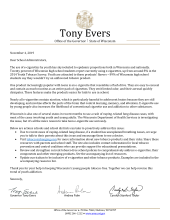Tobacco is Changing: Resources for Educators
Teachers, School Staff, and Administrators are on the Front Lines of Youth Tobacco Use
What happens in your classrooms, school hallways, and afterschool activities matters to the health of Wisconsin kids. Research by the Food and Drug Administration (FDA) suggests that when teachers talk about the health consequences of e-cigarettes, and schools enforce tobacco-free policies, students may be less likely to use tobacco. You can help young people make informed and healthy choices about tobacco use by providing students, their families, and school staff with reliable information about the dangers of tobacco, cessation tools and support, and more.
Hear from Governor Evers
Governor Tony Evers, Department of Health Services Secretary-designee Andrea Palm, and State Superintendent Carolyn Stanford Taylor are letting schools know what can be done to prevent youth e-cigarette use. In a joint letter on e-cigarettes to Wisconsin school district administrators, they outlined steps school districts can take to address the issue, like:
- Providing resources to strengthen tobacco-free school policies
- Adding the dangers of e-cigarette use into health curriculum
- Connecting addicted youth with resources to help them stop using tobacco
Spotting Tobacco Use in School
With so many new kinds of packaging and devices, it’s getting harder for busy teachers, and staff, to recognize the tobacco products in their own classrooms and after school activities, especially when some products are designed to hide in plain sight.
What to Look For:
- Hoodies, backpacks, and other wearable gear that connect hidden vapes to plastic tubes running through look-alike strings and straps.
- Colorful disposable e-cigs that look like slim highlighters or high-tech cigarettes.
- Sweet scents, like bubble gum, or chocolate cake, that don't have a clear source.
- Kids who keep devices that look like USB flash drives, credit cards, makeup compacts, or fidget spinners close at hand.
- Small bags, boxes, and tins that look like packaging for candy, gum, or breath mints.
- Uncharacteristic shortness of breath and other unexplained breathing issues.
How to Talk to Students at Every Grade Level
No two students are exactly the same, but by understanding what interests kids at different ages, and grade levels, teachers and staff can find effective ways to start open and engaging conversations about tobacco with students of every age.
Elementary School Kids
Elementary school kids are just starting to learn about the larger world. They like unusual facts. Talk to them about nicotine, the truth behind tricky tobacco that looks or tastes like candy, and the dangerous things tobacco’s gross ingredients can do to a growing brain and body.
Middle School Tweens
Middle school is all about friendship and finding your way. Engage your students by talking about tobacco’s waning popularity, the social costs of tobacco use (like early aging or becoming a poor athlete), how tobacco companies use flavors to hook youth, and how to deal with peer pressure.
High School Teens
Your students are starting to become independent thinkers. Now is the time to talk about why people choose to live tobacco-free, why never starting is easier (and cheaper) than quitting, as well as tobacco’s manipulative and unjust tactics. Discuss their future and the importance of healthy choices.
Help Your Students Quit
Nicotine is powerfully addictive in any form. Connect your students and their families to the resources, and support, they need to live tobacco-free for good.
Get Them Help
There is a network of free, and affordable, cessation resources for teens, including quitting coaches, peer support, and helplines that offer help by app, phone call, live chat, or texting.
Recommend 1-800-QUIT-NOW for free quitting support and more.
Offer students and families these additional resources:
Become an Ex
What Quitting Means to Teens
This Is Quitting
Become a Smoke-free Teen
Adopt INDEPTH at School
Developed by the American Lung Association, INDEPTH is a free alternative to tobacco-related suspensions or citations in schools. Instead of punishing students for their addiction, it helps young people understand nicotine’s effects and find healthy alternatives to tobacco use.
Download the program outline
See the program evaluation findings
Register to bring INDEPTH to your school
Take Action in Your School
You’re not only an educator, you’re a role model for kids, a trusted advisor to parents and caregivers, and a powerful influence on your colleagues and school environment. Add taking action against youth tobacco use to your academic calendar.
What You Can Do:
In Your Classroom and After School Activities
- Get to know tobacco’s products, tactics, and health effects.
- Keep an eye out for tobacco products.
- Update your curriculum to include tobacco-related lesson plans.
- Encourage youth to join student organizations that discourage tobacco use, like sports and the arts.
- Talk to your students about tobacco and its dangers.
With Parents and Caregivers
- Make sure caregivers know about your school’s youth tobacco use policies.
- Use parent-teacher conferences to talk about the dangers of youth tobacco use.
- Send tobacco updates and cessation resources home throughout the year.
- Encourage parents to talk tobacco at parent-teacher association events.
- Let parents and caregivers know about your local tobacco-free coalition.
In Your School
- Let your school administrators know that tobacco prevention matters to you.
- Review and strengthen your school’s tobacco-free policies.
- Join your local tobacco-free coalition and share what you know about the dangers of tobacco with others.
- Ask for tobacco-related training and professional development opportunities.
- Make sure staff can recognize and respond to student breathing issues.
Resources
Find more helpful tools and tips for educators on preventing youth tobacco use:
Taking Down Tobacco
The Truth Initiative
CTP’s Exchange Lab free posters








